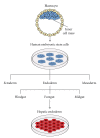Three-dimensional culture of human embryonic stem cell derived hepatic endoderm and its role in bioartificial liver construction
- PMID: 20169088
- PMCID: PMC2821762
- DOI: 10.1155/2010/236147
Three-dimensional culture of human embryonic stem cell derived hepatic endoderm and its role in bioartificial liver construction
Abstract
The liver carries out a range of functions essential for bodily homeostasis. The impairment of liver functions has serious implications and is responsible for high rates of patient morbidity and mortality. Presently, liver transplantation remains the only effective treatment, but donor availability is a major limitation. Therefore, artificial and bioartificial liver devices have been developed to bridge patients to liver transplantation. Existing support devices improve hepatic encephalopathy to a certain extent; however their usage is associated with side effects. The major hindrance in the development of bioartificial liver devices and cellular therapies is the limited availability of human hepatocytes. Moreover, primary hepatocytes are difficult to maintain and lose hepatic identity and function over time even with sophisticated tissue culture media. To overcome this limitation, renewable cell sources are being explored. Human embryonic stem cells are one such cellular resource and have been shown to generate a reliable and reproducible supply of human hepatic endoderm. Therefore, the use of human embryonic stem cell-derived hepatic endoderm in combination with tissue engineering has the potential to pave the way for the development of novel bioartificial liver devices and predictive drug toxicity assays.
Figures
Similar articles
-
Role of stem-cell-derived hepatic endoderm in human drug discovery.Biochem Soc Trans. 2010 Aug;38(4):1033-6. doi: 10.1042/BST0381033. Biochem Soc Trans. 2010. PMID: 20658999 Review.
-
Hepatic endoderm differentiation from human embryonic stem cells.Curr Stem Cell Res Ther. 2010 Sep;5(3):233-44. doi: 10.2174/157488810791824403. Curr Stem Cell Res Ther. 2010. PMID: 20214561 Review.
-
Hepatic differentiation of human embryonic stem cells is promoted by three-dimensional dynamic perfusion culture conditions.Tissue Eng Part C Methods. 2011 May;17(5):557-68. doi: 10.1089/ten.TEC.2010.0437. Epub 2011 Feb 15. Tissue Eng Part C Methods. 2011. PMID: 21210720
-
Progress and future challenges in stem cell-derived liver technologies.Am J Physiol Gastrointest Liver Physiol. 2009 Aug;297(2):G241-8. doi: 10.1152/ajpgi.00138.2009. Epub 2009 Jun 11. Am J Physiol Gastrointest Liver Physiol. 2009. PMID: 19520740 Review.
-
Bioinspired Engineering for Liver Tissue Regeneration and Development of Bioartificial Liver: A Review.Crit Rev Biomed Eng. 2018;46(5):413-427. doi: 10.1615/CritRevBiomedEng.2018028276. Crit Rev Biomed Eng. 2018. PMID: 30806261 Review.
Cited by
-
Bioartificial liver devices: Perspectives on the state of the art.Front Med. 2011 Mar;5(1):15-9. doi: 10.1007/s11684-010-0110-x. Epub 2010 Nov 19. Front Med. 2011. PMID: 21088931 Review.
-
A preliminary study for constructing a bioartificial liver device with induced pluripotent stem cell-derived hepatocytes.Biomed Eng Online. 2012 Dec 7;11:93. doi: 10.1186/1475-925X-11-93. Biomed Eng Online. 2012. PMID: 23217363 Free PMC article.
-
Patterned Fibers Embedded Microfluidic Chips Based on PLA and PDMS for Ag Nanoparticle Safety Testing.Polymers (Basel). 2016 Nov 16;8(11):402. doi: 10.3390/polym8110402. Polymers (Basel). 2016. PMID: 30974676 Free PMC article.
-
Self-Organized Liver Microtissue on a Bio-Functional Surface: The Role of Human Adipose-Derived Stromal Cells in Hepatic Function.Int J Mol Sci. 2020 Jun 29;21(13):4605. doi: 10.3390/ijms21134605. Int J Mol Sci. 2020. PMID: 32610471 Free PMC article.
-
Stem cell differentiation and human liver disease.World J Gastroenterol. 2012 May 7;18(17):2018-25. doi: 10.3748/wjg.v18.i17.2018. World J Gastroenterol. 2012. PMID: 22563188 Free PMC article. Review.
References
-
- Ramadori G, Moriconi F, Malik I, Dudas J. Physiology and pathophysiology of liver inflammation, damage and repair. Journal of Physiology and Pharmacology. 2008;59(supplement 1):107–117. - PubMed
-
- Court FG, Wemyss-Holden SA, Dennison AR, Maddern GJ. Bioartificial liver support devices: historical perspectives. ANZ Journal of Surgery. 2003;73(9):739–748. - PubMed
-
- Raia S, Nery JR, Mies S. Liver transplantation from live donors. The Lancet. 1989;2(8661):p. 497. - PubMed
-
- Seaman DS. Adult living donor liver transplantation: current status. Journal of Clinical Gastroenterology. 2001;33(2):97–106. - PubMed
Publication types
MeSH terms
LinkOut - more resources
Full Text Sources
Other Literature Sources


